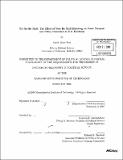| dc.contributor.advisor | Stephen D. Ansolabehere. | en_US |
| dc.contributor.author | Sled, Sarah Marie | en_US |
| dc.contributor.other | Massachusetts Institute of Technology. Dept. of Political Science. | en_US |
| dc.coverage.spatial | n-us--- | en_US |
| dc.date.accessioned | 2009-08-26T17:09:00Z | |
| dc.date.available | 2009-08-26T17:09:00Z | |
| dc.date.copyright | 2008 | en_US |
| dc.date.issued | 2008 | en_US |
| dc.identifier.uri | http://hdl.handle.net/1721.1/46634 | |
| dc.description | Thesis (Ph. D.)--Massachusetts Institute of Technology, Dept. of Political Science, 2008. | en_US |
| dc.description | Includes bibliographical references (leaves 81-84). | en_US |
| dc.description.abstract | The goal of this dissertation is to aid our understanding of how electoral institutions in the United States affect political participation and, in turn, shape policy outcomes. I investigate this relationship by analyzing the all-mail balloting method known as Vote By Mail. Using a data set of 3310 cases representing elections in 7 states, I show that the use of Vote By Mail produces an overall effect of a 10 percentage point increase in turnout across all types of elections. This finding is consistent with past research, which states that the increase in turnout occurs because Vote By Mail, similar to other "ease of voting" reforms, reduces the cost of voting. As an alternative hypothesis, I propose that the turnout increase from Vote By Mail is a more nuanced effect, moderated by the salience of a given election. I then organize these elections into low salience and high salience categories, and demonstrate that the turnout effect is more nuanced than previously thought. The implementation of Vote By Mail produces turnout effects that increase in magnitude as the salience of the election decreases, with a range from 3.4 percentage points increase in the high salience category of presidential general elections to an increase in turnout of 15 percentage points in the low salience category of local special elections. I then examine whether an increase in voter turnout results in an shift of the electorate's policy preferences. Comparing the outcomes of school bond measures in Vote By Mail elections with traditional elections, I show there is no statistically significant difference in the likelihood of passage of school bond measures. Furthermore, there is no statistically significant difference in percentage of "Yes" votes received on these measures. This analysis demonstrates that the increased turnout resulting from the use of Vote By Mail elections does not produce a shift in the policy preferences of the median voter. | en_US |
| dc.description.statementofresponsibility | by Sarah Marie Sled. | en_US |
| dc.format.extent | 84 leaves | en_US |
| dc.language.iso | eng | en_US |
| dc.publisher | Massachusetts Institute of Technology | en_US |
| dc.rights | M.I.T. theses are protected by
copyright. They may be viewed from this source for any purpose, but
reproduction or distribution in any format is prohibited without written
permission. See provided URL for inquiries about permission. | en_US |
| dc.rights.uri | http://dspace.mit.edu/handle/1721.1/7582 | en_US |
| dc.subject | Political Science. | en_US |
| dc.title | It's in the mail : the effect of vote by mail balloting on voter turnout and policy outcomes in U.S. elections | en_US |
| dc.title.alternative | It is in the mail : the effect of vote by mail balloting on voter turnout and policy outcomes in U.S. elections | en_US |
| dc.title.alternative | Effect of vote by mail balloting on voter turnout and policy outcomes in U.S. elections | en_US |
| dc.type | Thesis | en_US |
| dc.description.degree | Ph.D. | en_US |
| dc.contributor.department | Massachusetts Institute of Technology. Department of Political Science | |
| dc.identifier.oclc | 426172518 | en_US |
